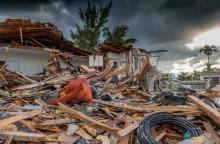Oil Spills
- 1910
- March 14, Kern County, Caifornia: Called the Lakeview Gusher Number One, this hydrocarbon eruption because the largest accidental oil spill in history. It lasted 18 months and spilled 9 million barrels of crude oil at Midway-Sunset Oil Field.
- 1976
- Dec. 15, Buzzards Bay, Mass.: Argo Merchant ran aground and broke apart southeast of Nantucket Island, spilling its entire cargo of 7.7 million gallons of fuel oil.
- 1989
- March 24, Prince William Sound, Alaska: tanker Exxon Valdez hit an undersea reef and released 10 million–plus gallons of oil into the water.
- 1990
- June 8, off Galveston, Tex.: Mega Borg released 5.1 million gallons of oil some 60 nautical miles south-southeast of Galveston as a result of an explosion and subsequent fire in the pump room.
- 1993
- Aug. 10, Tampa Bay, Fla.: three ships collided, the barge Bouchard B155, the freighter Balsa 37, and the barge Ocean 255. The Bouchard spilled an estimated 336,000 gallons of No. 6 fuel oil into Tampa Bay.
- 2000
- Nov. 28, Mississippi River south of New Orleans: oil tanker Westchester lost power and ran aground near Port Sulphur, La., dumping 567,000 gallons of crude oil into lower Mississippi. Spill was largest in U.S. waters since Exxon Valdez disaster in March 1989.
- 2004
- Dec. 7, Unalaska, Aleutian Islands, Alaska: A major storm pushed the M/V Selendang Ayu up onto a rocky shore, breaking it in two. 337,000 gallons of oil were released, most of which was driven onto the shoreline of Makushin and Skan Bays.
- 2005
- Aug.-Sept., New Orleans, Louisiana: The Coast Guard estimated that more than 7 million gallons of oil were spilled during Hurricane Katrina from various sources, including pipelines, storage tanks and industrial plants.
- 2006
- June 19, Calcasieu River, Louisiana: An estimated 71,000 barrels of waste oil were released from a tank at the CITGO Refinery on the Calcasieu River during a violent rain storm.
- 2008
- July 25, New Orleans, Louisiana: A 61-foot barge, carrying 419,000 gallons of heavy fuel, collides with a 600-foot tanker ship in the Mississippi River near New Orleans. Hundreds of thousands of gallons of fuel leak from the barge, causing a halt to all river traffic while cleanup efforts commence to limit the environmental fallout on local wildlife.
- 2010
- Jan. 23, Port Arthur, Texas: The oil tanker Eagle Otome and a barge collide in the Sabine-Neches Waterway, causing the release of about 462,000 gallons of crude oil. Environmental damage was minimal as about 46,000 gallons were recovered and 175,000 gallons were dispersed or evaporated, according to the U.S. Coast Guard.
- April 24, Gulf of Mexico: The Deepwater Horizon, a semi-submersible drilling rig, sank on April 22, after an April 20th explosion on the vessel. Eleven people died in the blast and 205.8 million gallons of oil leaked into the waters. When the rig sank, the riser—the 5,000-foot-long pipe that connects the wellhead to the rig—became detached and began leaking oil. In addition, U.S. Coast Guard investigators discovered a leak in the wellhead itself. As much as 60,000 barrels of oil per day were leaking into the water, threatening wildlife along the Louisiana Coast. Homeland Security Secretary Janet Napolitano declared it a "spill of national significance." BP (British Petroleum), which leased the Deepwater Horizon, is responsible for the cleanup, but the U.S. Navy supplied the company with resources to help contain the slick. Oil reached the Louisiana shore on April 30, affected about 125 miles of coast. By early June, oil had also reached Florida, Alabama, and Mississippi. It is the largest oil spill in U.S. history.

| Worst United States Disasters |








